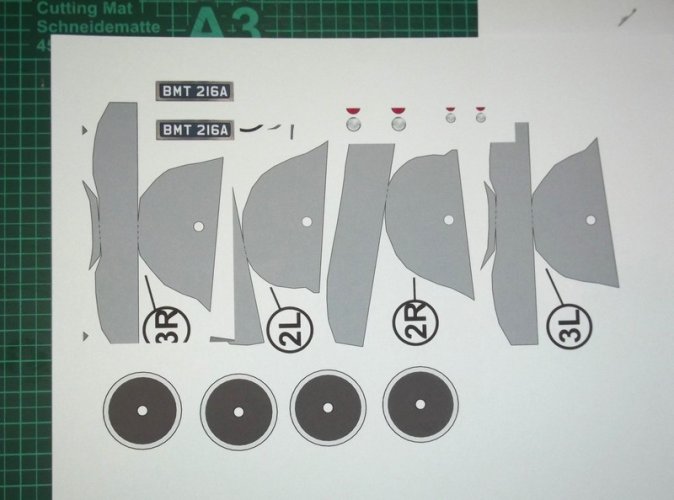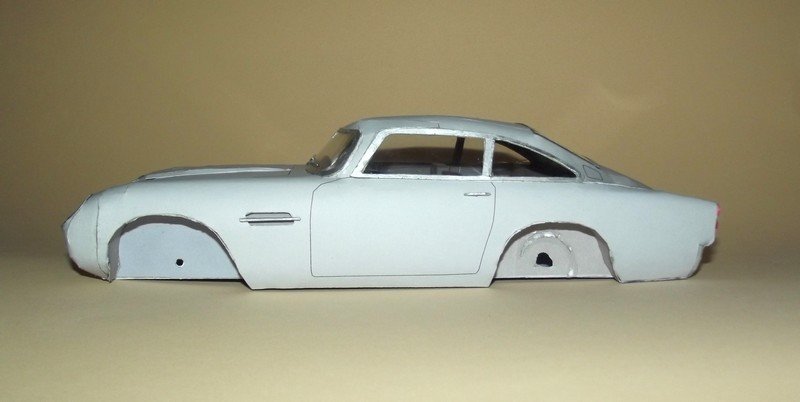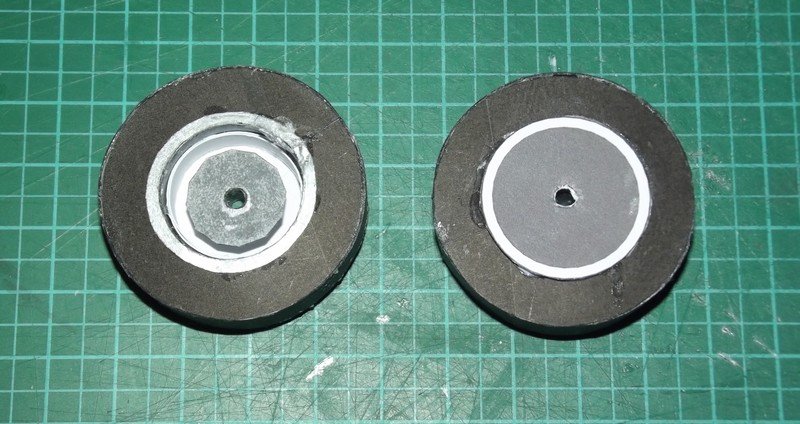James Bond's Aston Martin DB5
- Thread starter Revell-Fan
- Start date
You are using an out of date browser. It may not display this or other websites correctly.
You should upgrade or use an alternative browser.
You should upgrade or use an alternative browser.
I would if it wasn't so "stinky". In addition, I would have to order it and I don't want to pay so much for just one model. 
- Apr 5, 2013
- 13,876
- 10,215
- 228
The "Electrical Tape" I use is not stinky at all. It comes in small bottles, so doesn't cost much at all. Once you have it, you will find yourself using it on many models because as it's drying, it's easy to push textures into it. 
I really appreciate your tips. However, I don't see anything below 9 € + shipping which is too expensive for me since I have no idea IF that stuff the are offering works at all. The risk is just too great. You cannot imagine how much trouble I have to get water-clear printable transparent sheet. That is the main reason why I'm stuck with my Crichton build. :/The "Electrical Tape" I use is not stinky at all. It comes in small bottles, so doesn't cost much at all. Once you have it, you will find yourself using it on many models because as it's drying, it's easy to push textures into it.
- Apr 5, 2013
- 13,876
- 10,215
- 228
If you went into an electric repair supply shop, they would have small bottles of the stuff, as it is used widely in electronics. You can prepare paper by clear coating it if you think it will penetrate. I've never that problem. 
Erh, please let me show you some images of the town where I live.If you went into an electric repair supply shop, ...
This is the market place:
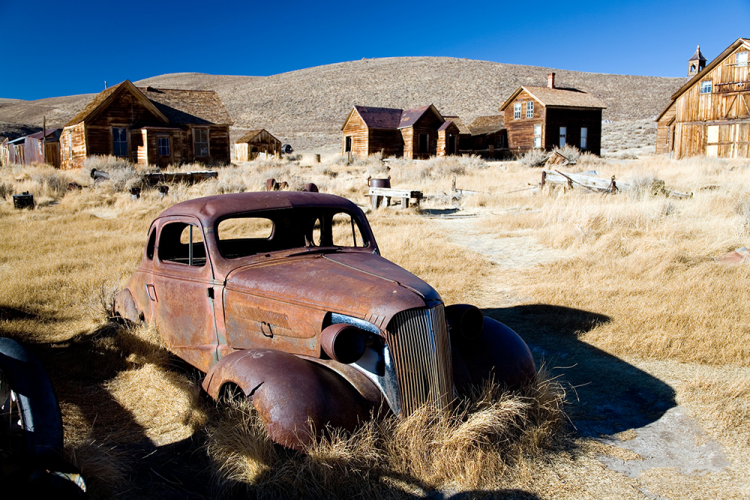
My old school:
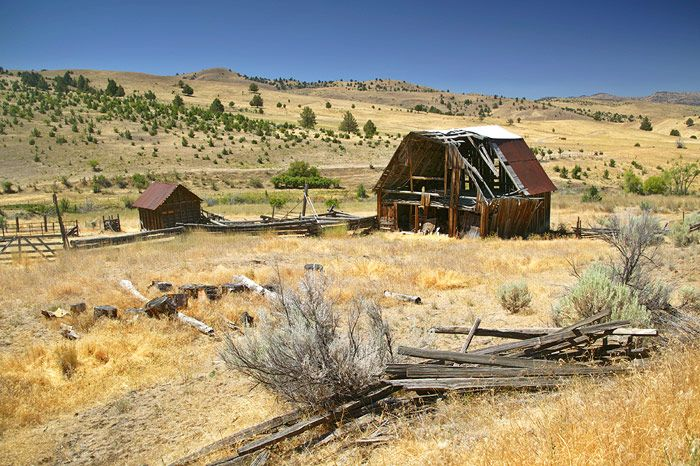
The residential area:
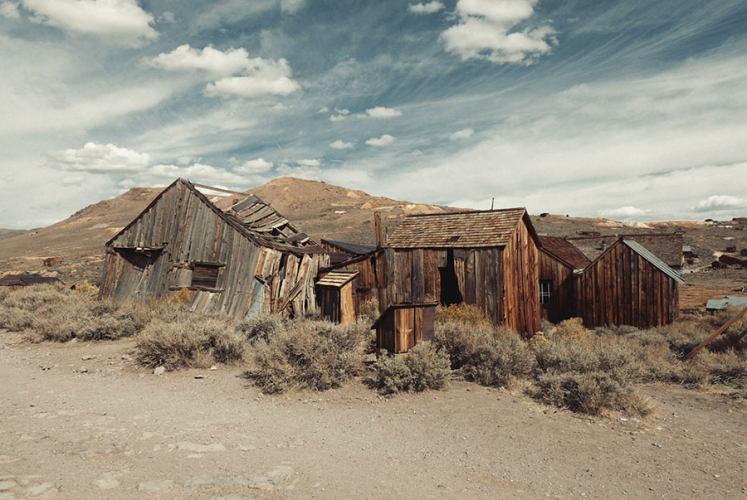
Pretty hard to find a shop offering those bottles...



(Granted, the real situation is not all that severe, sometimes I tap into a cactus to get some drinking water, but yaknow, I guess you get the meaning. I once was at our local DIY store to ask if they had some foam to use as padding for the Colonial helmet. They wanted to sell me hard foam for isolating walls despite the fact that they were selling seat cushions with foam padding for clearance at the entrance. And when I asked them for an acrylic tube for the Cylon rifle they actually meant I was looking for a hose! NO KIDDING! Now I cannot imagine what they would think if I asked them for liquid rubber in a bottle..!
Last edited:
Here we go again! 
I still owe you a picture of the finished seat. Well, here it is. Assembly was straight-forward.
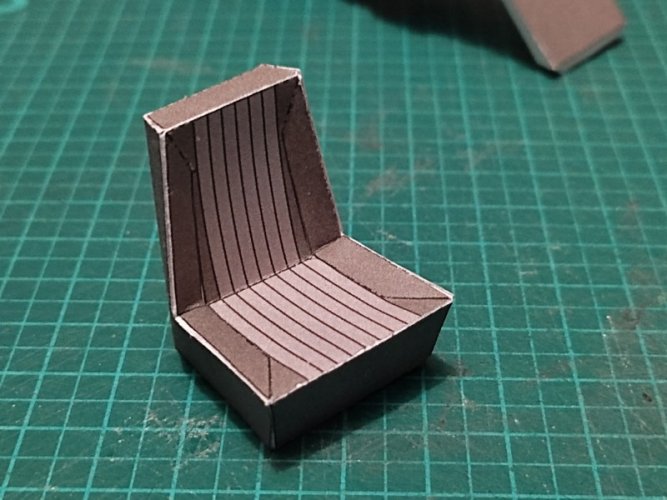
The edges were then painted with a marker.
First test-fit of the main interior components:
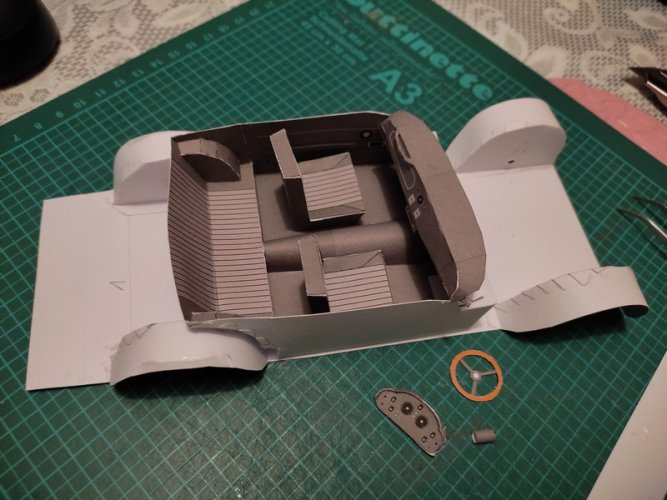
The lack of position marks makes the assembly extremely difficult. This is why I put everything aside and waited till the outer hull was finished. The side windows determine the position the seats have to be glued to the interior tub. I chose to glue the instrument panel into the middle of the empty space of the dasshboard. I don't like flying blind and this is what can really suck the fun out of the build. Ah well. I have started it, I have to finish it.
I still owe you a picture of the finished seat. Well, here it is. Assembly was straight-forward.

The edges were then painted with a marker.
First test-fit of the main interior components:

The lack of position marks makes the assembly extremely difficult. This is why I put everything aside and waited till the outer hull was finished. The side windows determine the position the seats have to be glued to the interior tub. I chose to glue the instrument panel into the middle of the empty space of the dasshboard. I don't like flying blind and this is what can really suck the fun out of the build. Ah well. I have started it, I have to finish it.
Back to the frame.
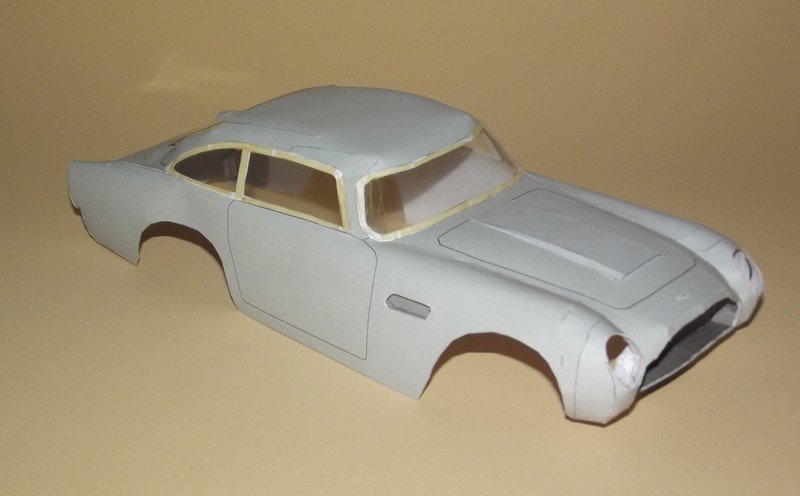
The window frames were painted silver and attached with double-sided tape.
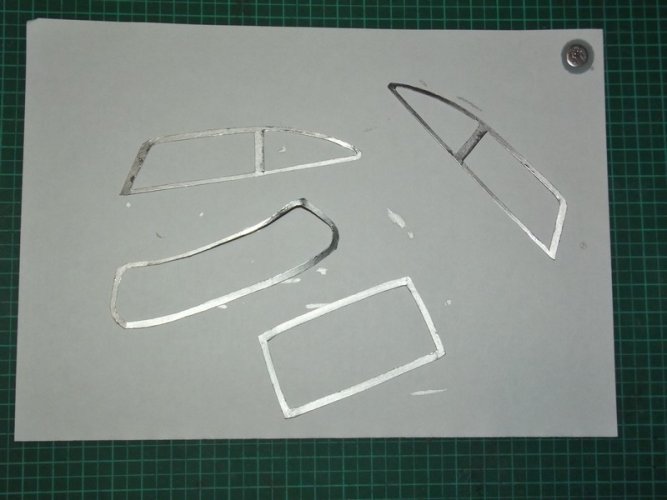
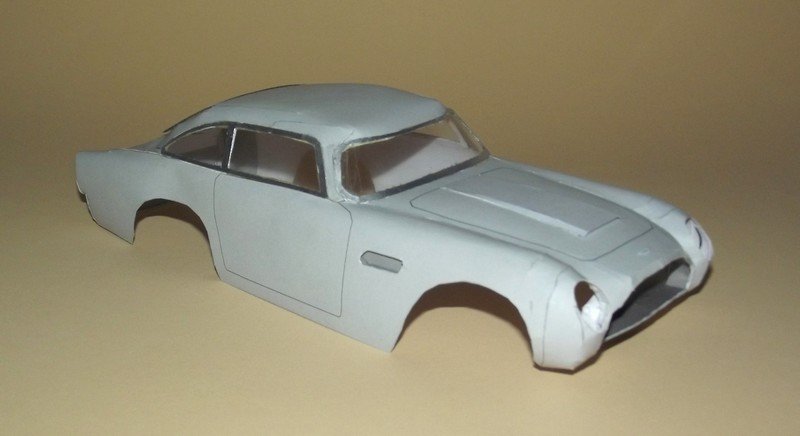
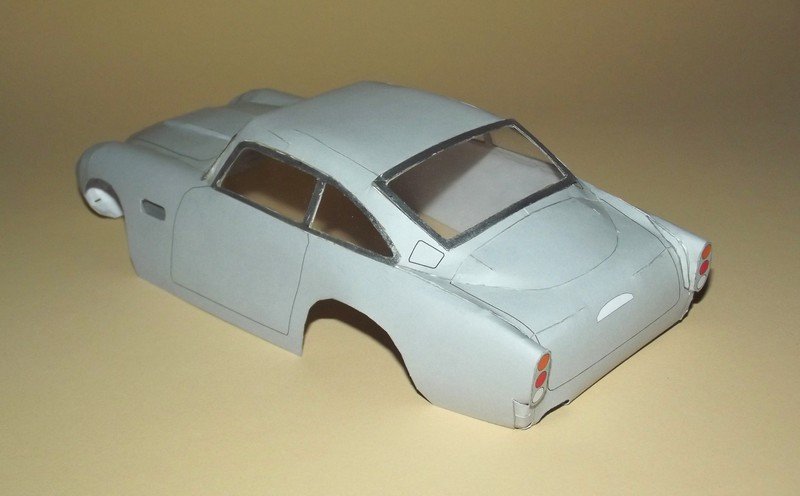
With the basic hull completed the interior parts are attached.
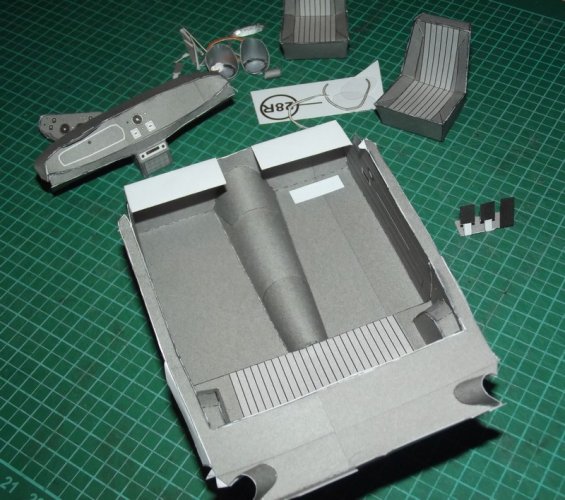
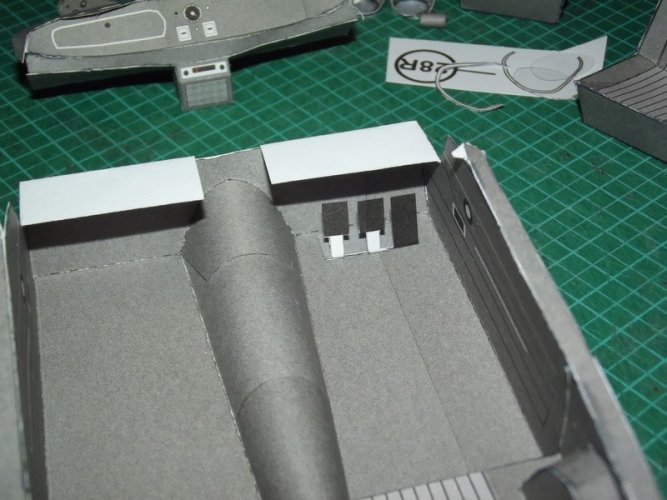
The only parts which have glue marks are the pedals and the indoor handles.
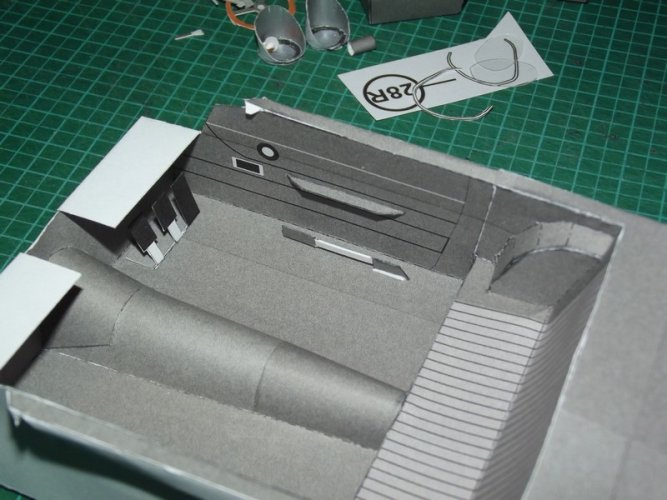
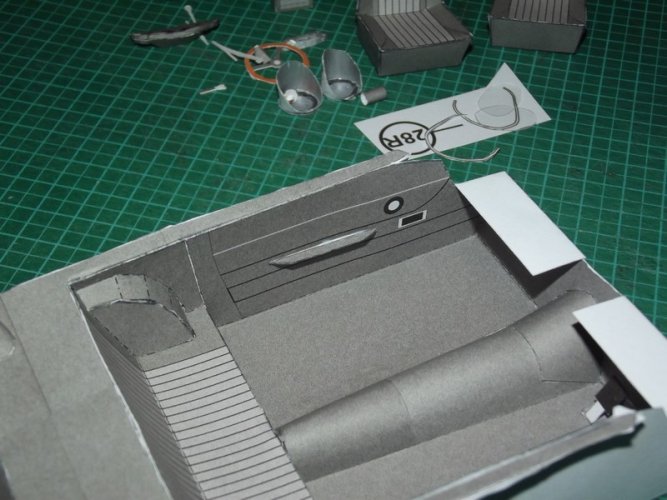
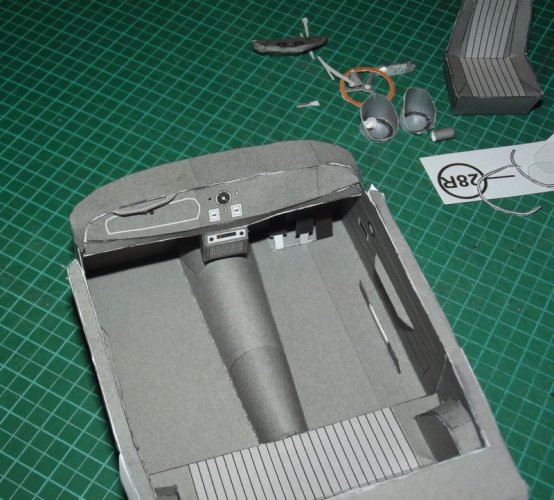
The position of the handbrake is to be determined. And of course I glued it to far away from the door so that the seat did not fit any more. So I ripped the handbrake off and glued it almost directly to the door.
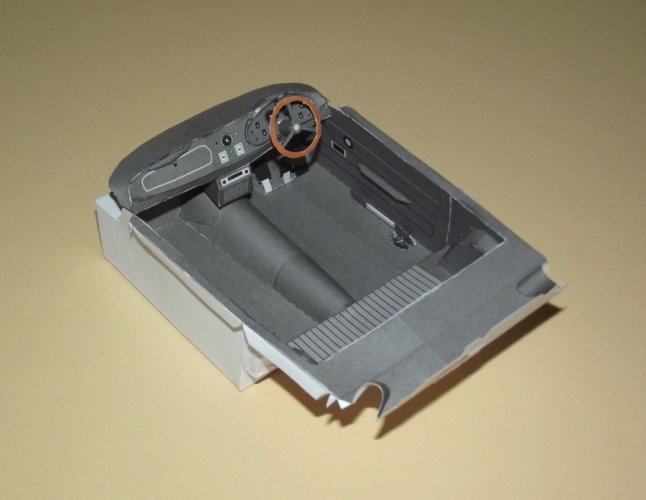


The window frames were painted silver and attached with double-sided tape.



With the basic hull completed the interior parts are attached.


The only parts which have glue marks are the pedals and the indoor handles.



The position of the handbrake is to be determined. And of course I glued it to far away from the door so that the seat did not fit any more. So I ripped the handbrake off and glued it almost directly to the door.


I put the hull beside the inner tub to see where the seats have to be attached.
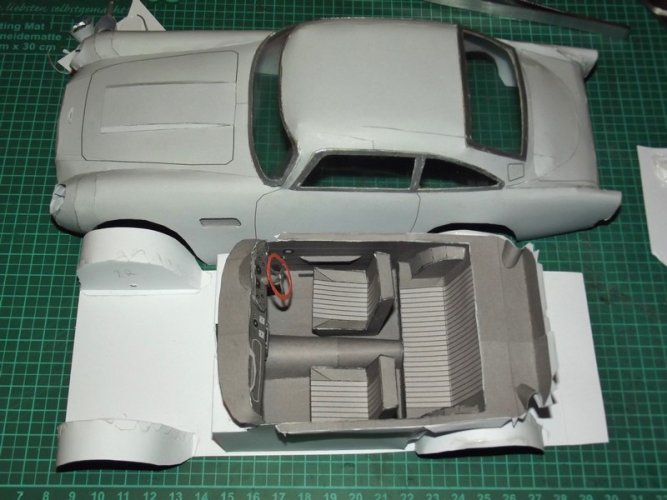
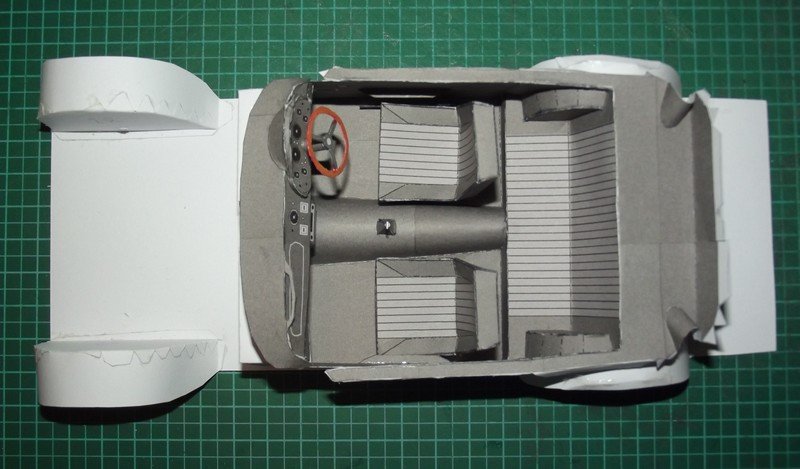
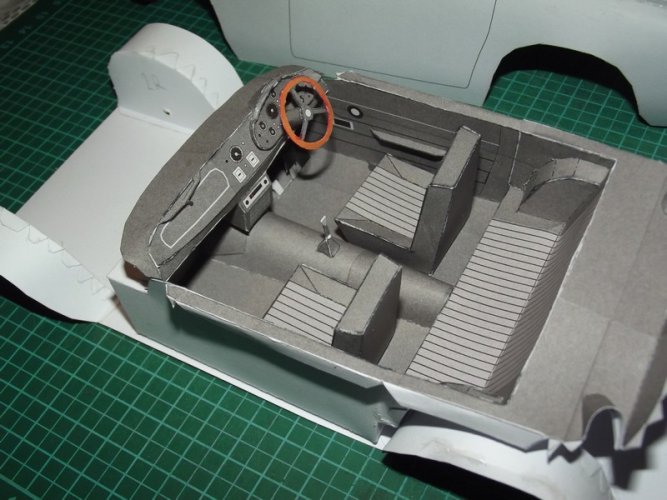
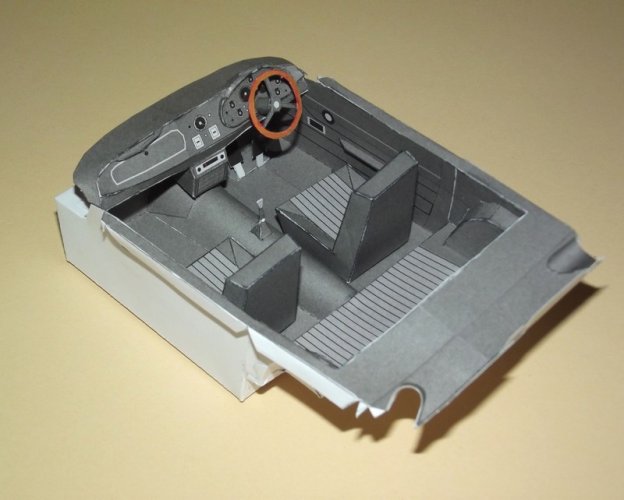
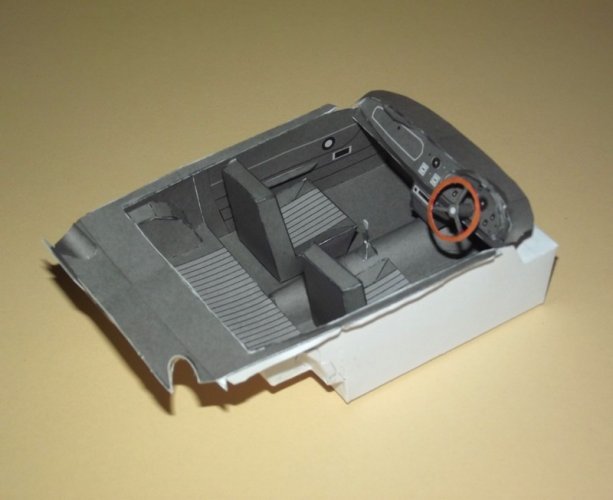
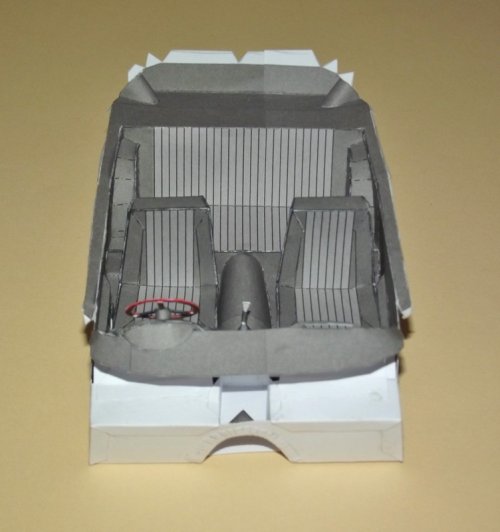
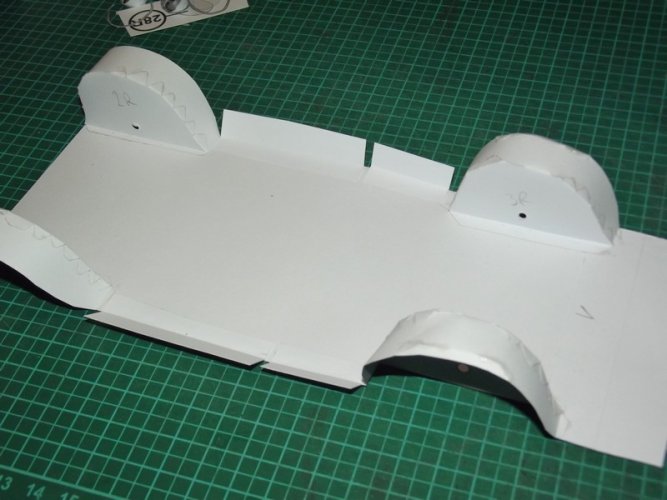
I added some flaps to the middle. More will be added to the rim of the entire bottom piece.
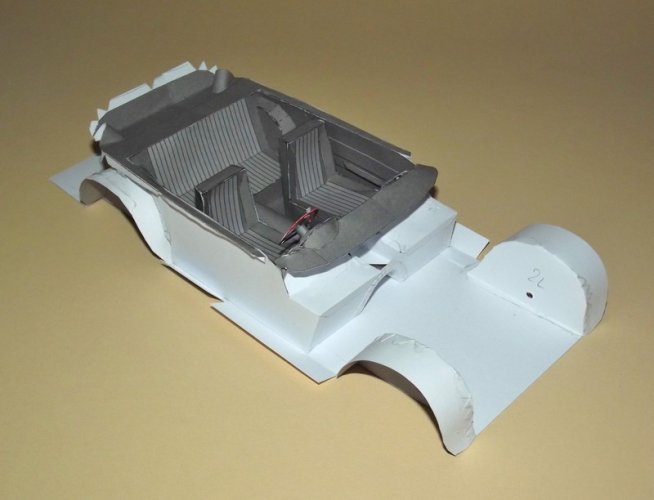
The tub was glued to the bottom.
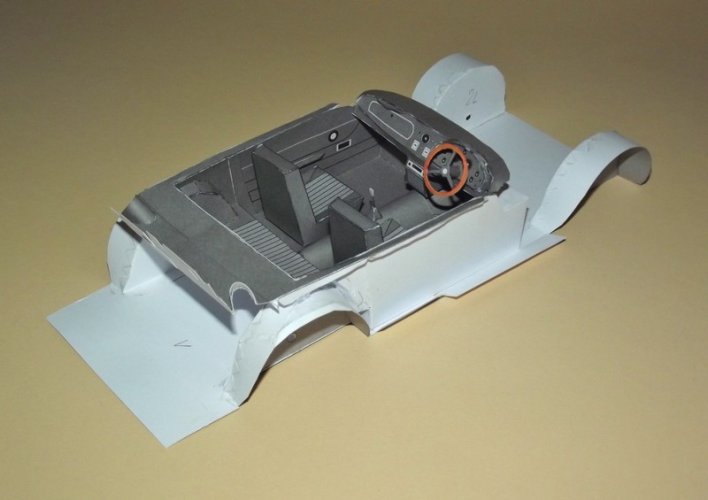
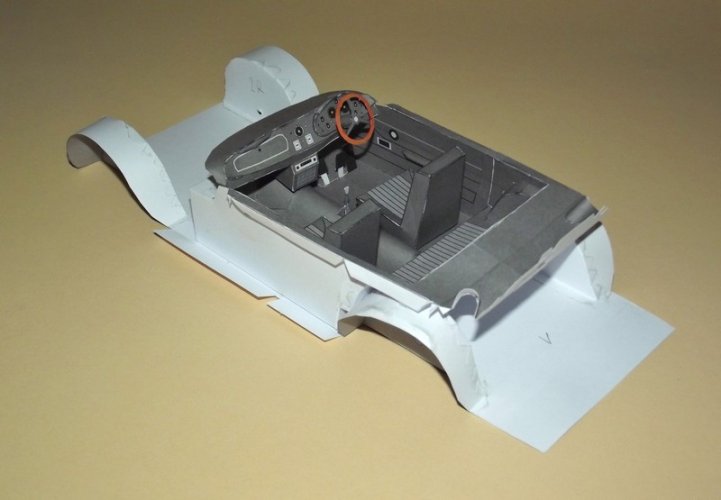
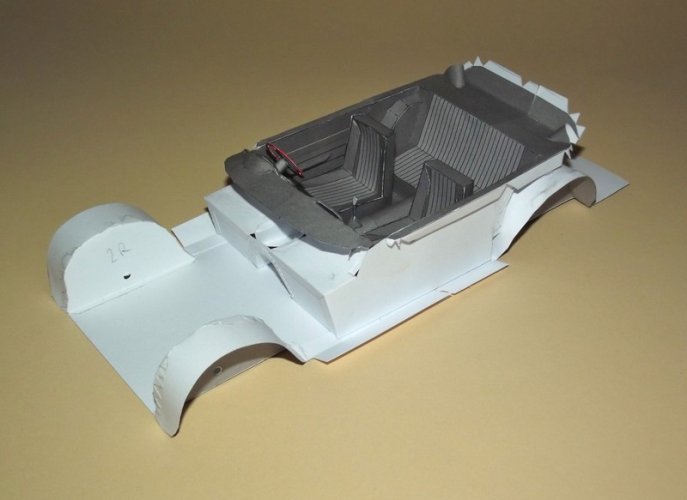
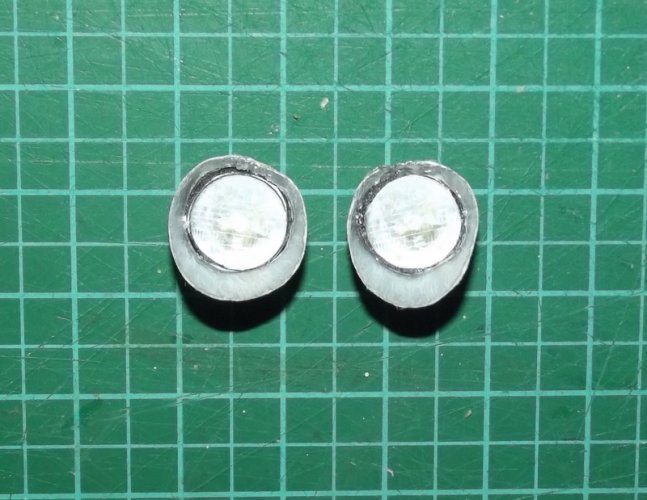
I found some good views at the original front and tail lights and glued a picture of them to the kit parts. This improves the look.
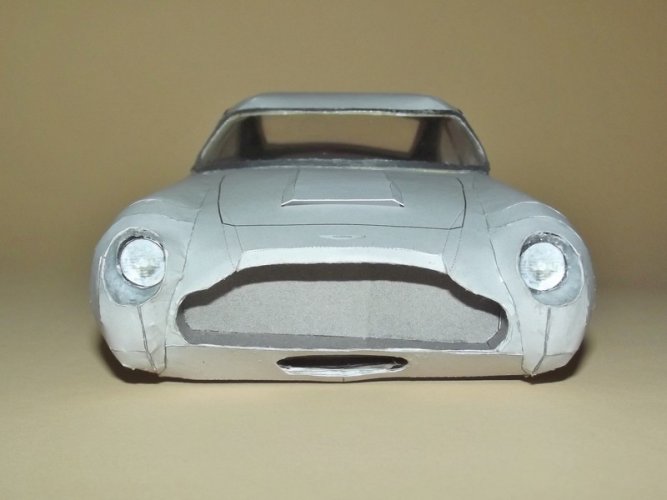
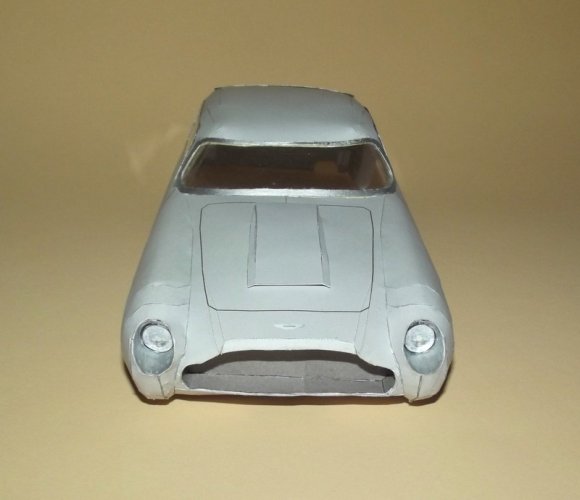
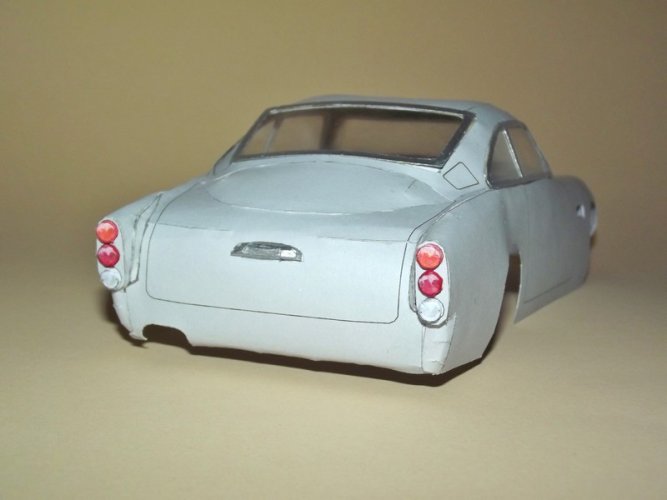
I guess we are on the finishing line, folks!







I added some flaps to the middle. More will be added to the rim of the entire bottom piece.

The tub was glued to the bottom.




I found some good views at the original front and tail lights and glued a picture of them to the kit parts. This improves the look.



I guess we are on the finishing line, folks!
Very nice work indeed, and love the pictures of your home town... which one is the pub/bar? 
This is coming together nicely! I wholeheartedly understand the frustration of not having proper placement markers. It does hamper the build. However, at the point that you are at now, "in for a penny, in for a pound."
As for the photos of the town, I like the look of it! The car that is in the town centre, is that the general delivery vehicle, public transit, or police car?
As for the photos of the town, I like the look of it! The car that is in the town centre, is that the general delivery vehicle, public transit, or police car?
This model is gomming together verry nice. As I said before you arr gifted with the touch of Merlin.
Time has come to join the two halves of the body.
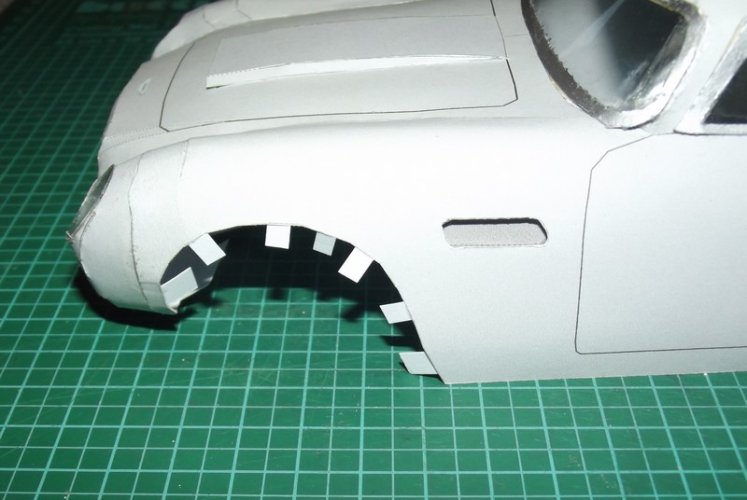
I added some flaps to the wheel boxes to give the bottom something to hold on to.
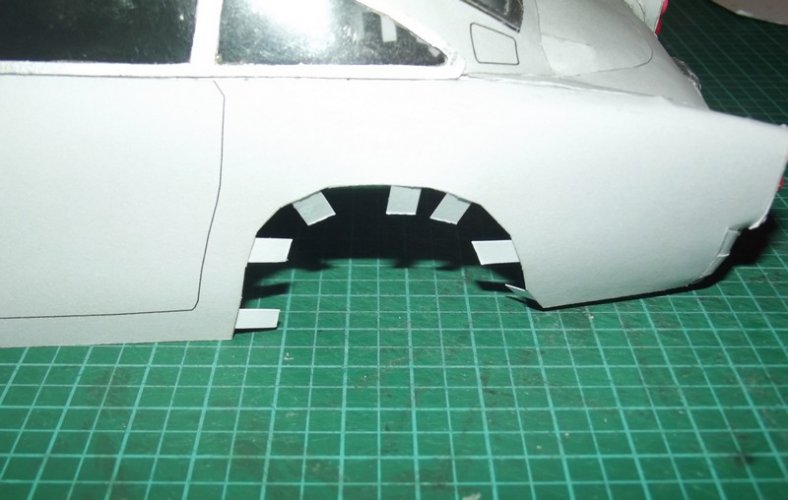
I painted the inner window frames grey to blend them into the basic colour of the interior. Leaving them light grey would make them show on the final model.
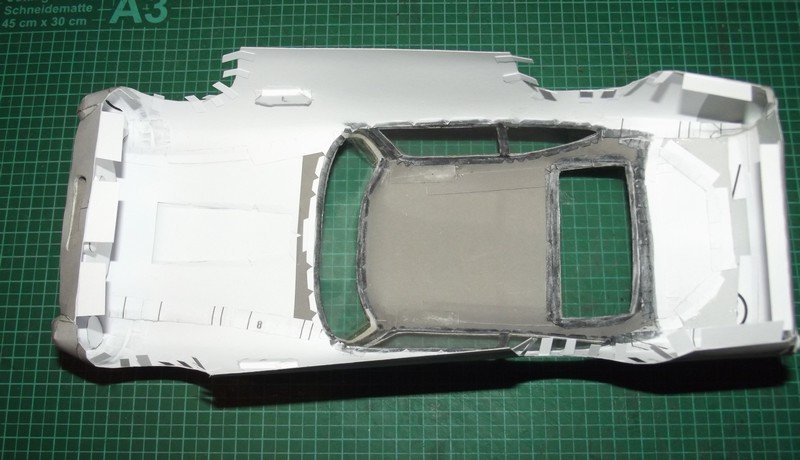
When I was dry-fitting both body halves I was shocked: The driver's cabin sat much too low in the body! I was trying back and forth to make that darn thing fit as intended but to no avail. The instructions do not tell you whether the tub has to be attached to the bottom or to the body frame. As I found out the hard way it has to be attached to the body frame. My mood was not the best, I can tell you.
So I printed another bottom (this time with added flaps), cut the old bottom to pieces to retrieve the cabin and glued the cabin to the body frame.
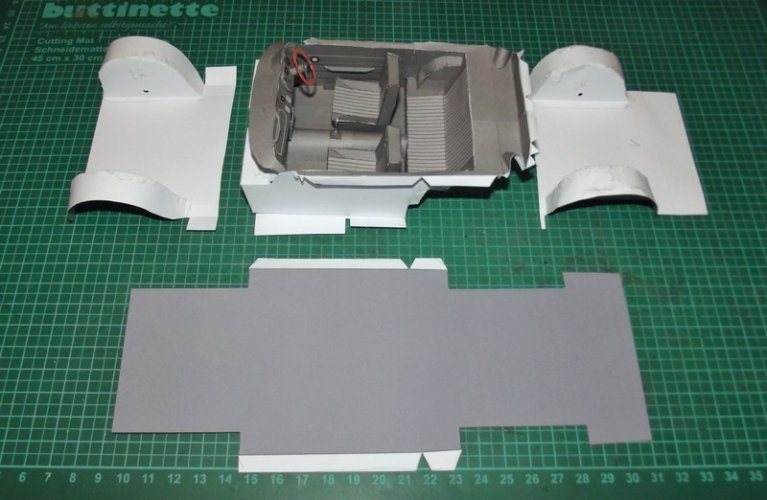
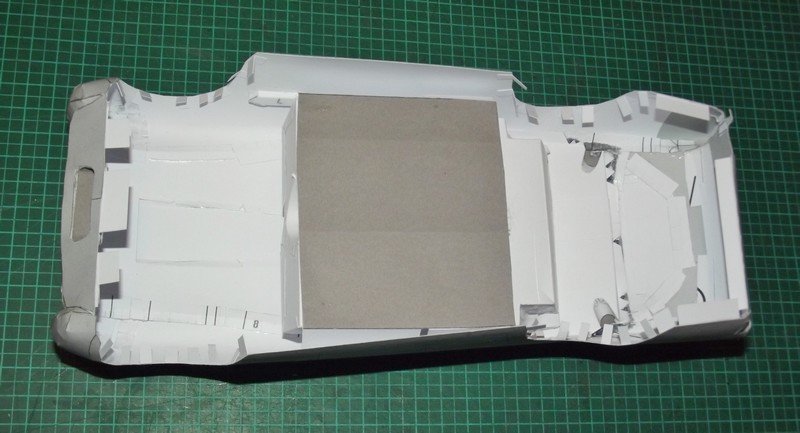
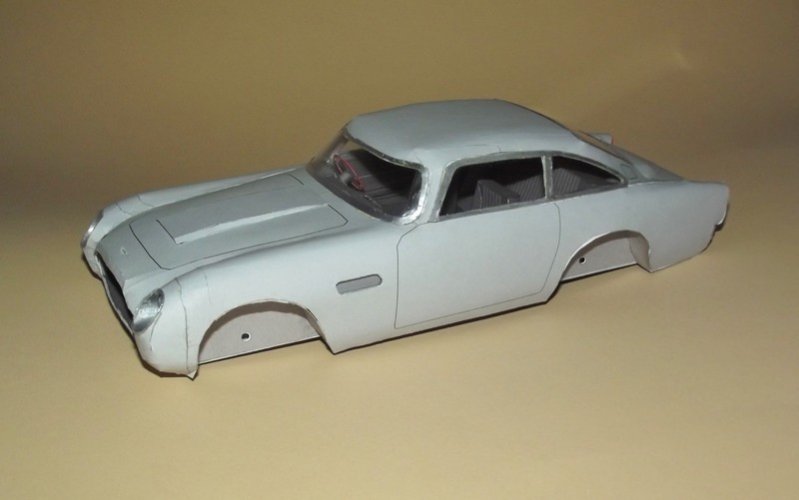
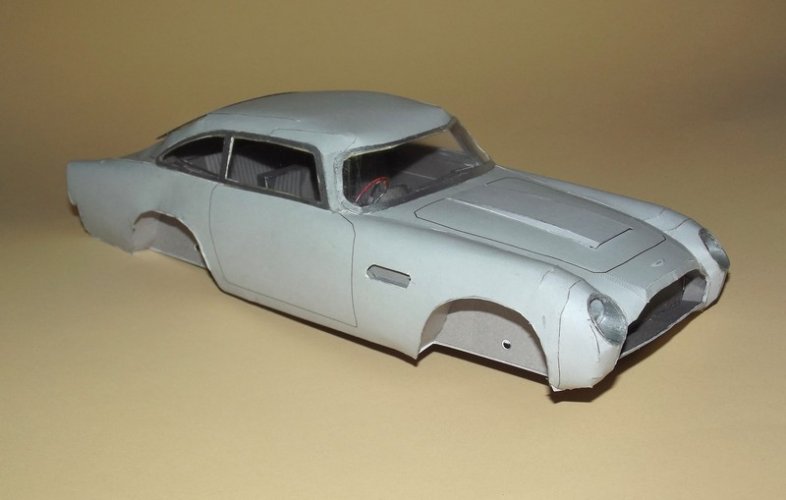
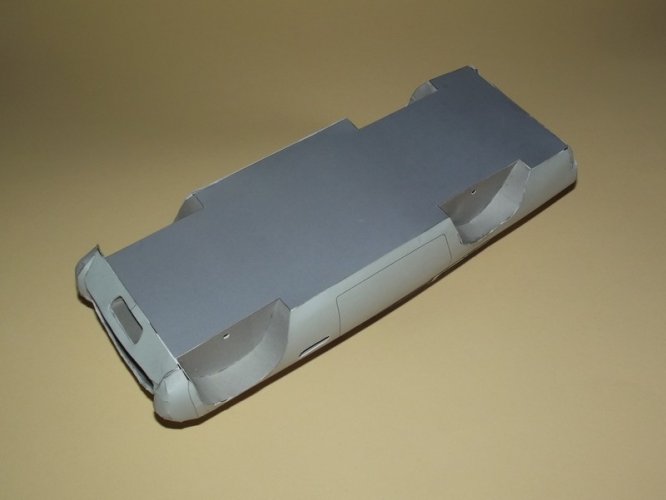
As a result of this the bottom looked much cleaner now since I had re-arranged the parts to print the part on one page. In addition, because of my sponsored ink I used the high quality printing setting so that there are no longer visible streaks on the bottom.
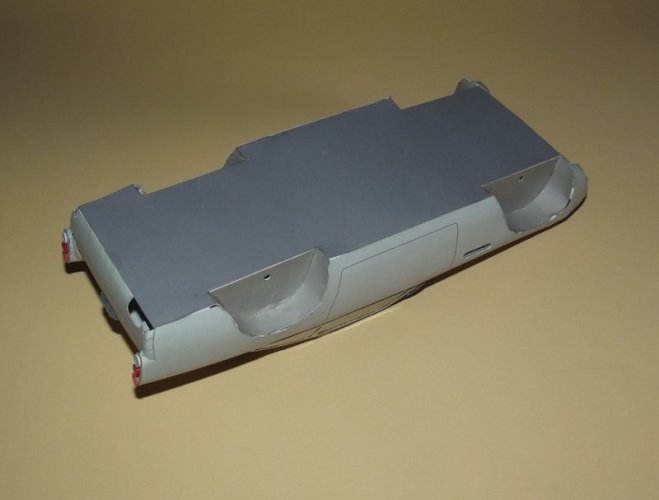
It was quite a struggle to line everything up. Due to the tropic temperatures here there was a constant danger of leaving sweat stains on the body but I was lucky. I started at the rear and worked myself to the front. Everything proceeded as planned. A few edges were visible but they were painted. I liked the result pretty much.
After that I began work on the detailing.
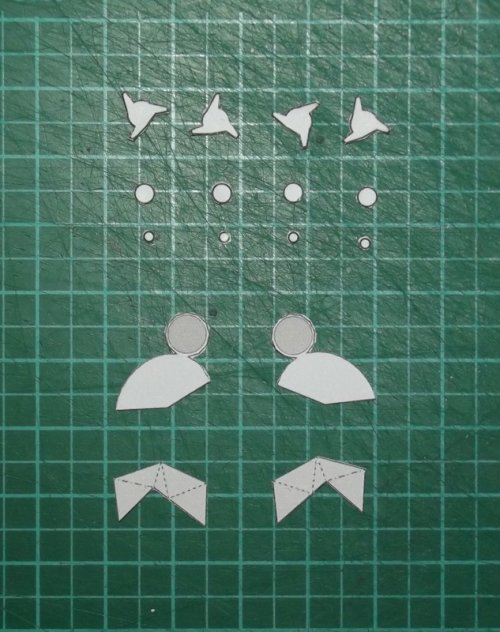
These are the parts for the side mirrors and the rim detailing.
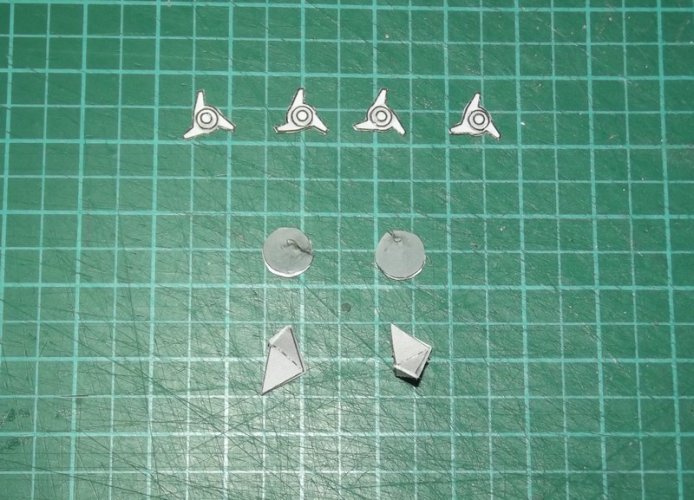
The mirror mount was straight forward. Just follow the folding marks.

The open area is glued to the chassis later.
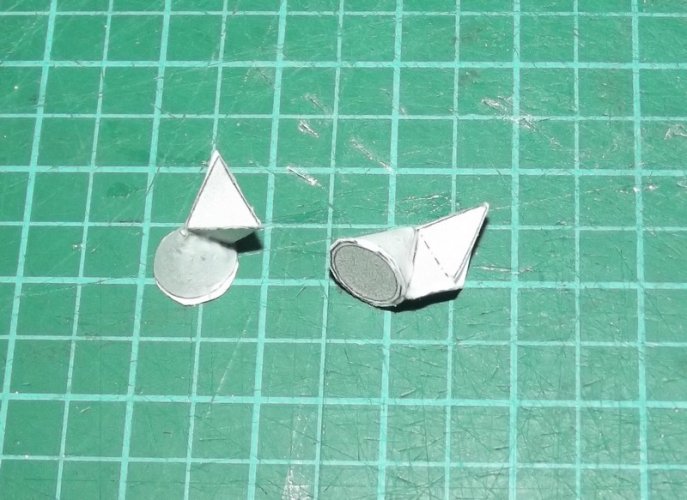
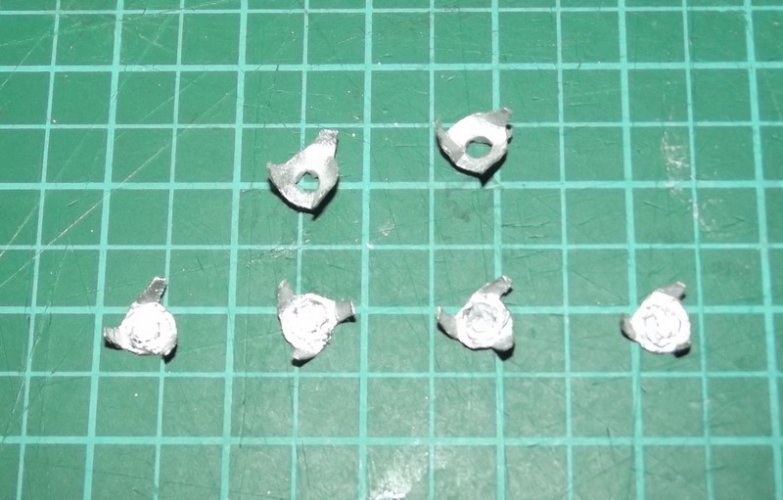
I added two more parts for a special effect. All parts were painted silver. So far so good. Then came the wheels.
The wheels are designed in such a strange way. A traditional wheel would feature two even sides which would provide enough material for mounting. The wheels of this kit are nothing like this. I am not a fan of them and I have no idea why the designer created them that way. They consist of way too many parts, construction is very time consuming and on the finished model you do not see most of the work that went into its construction. The inner rim is hollow. The provided holes in the middle of the rim are good for positioning but they are too big for toothpicks and too small for shashlik rods. So I chose to glue the ring of the inner rim directly to the wheel box. That of course looked strange, the wheels sat too close to the body. So I cut them off again which led to some minor damage to the wheel boxes and rims.
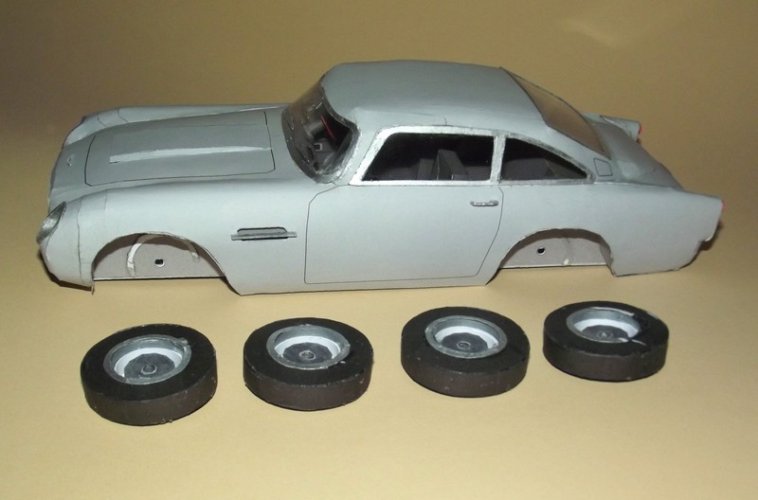
Looking at the front of the chassis I noticed that there was no rear mirror included. Of course the main body was glued tightly together and every attempt of opening it again would lead to its imminent destruction. So I decided to glue a small rectangle painted in silver to the outide of the front window.
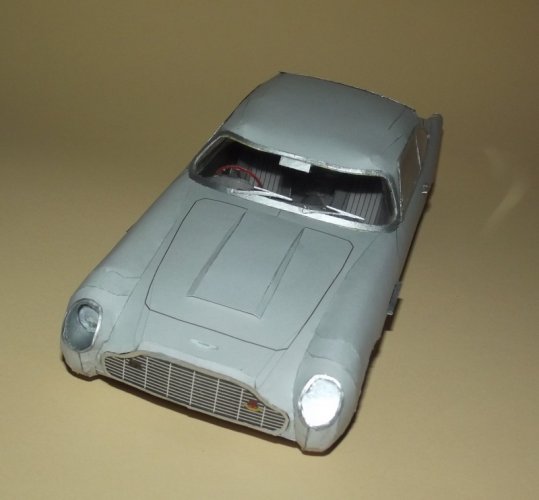
Since it is reflective you don't really notice that the mirror was glued to the outside.
Another part which eludes me is the front grill. Once you attach it you don't see anything behind it any longer. This is also frustrating considering how much time went into the construction of the recess (which I carefully transplanted from the first build as you remember). However, this design choice can be explained. If you print the grill on transparent sheet and attach it or if you add a real grid you could see through it and see the recess which would add a 3D effect. Nevertheless a small note in the instructions could have told the builder to skip the recess and attach the grill directly.
The front lights were equipped with clear lenses. Again, the kit does not offer a template for them.
To make things clear: The model is beautiful but the kit is riddled with very odd design choices like over-desigend parts the detail of which cannot be appreciated on the final model, unclear foldings, missing placement marks, hollow inner rims on the wheels, no wheel spacers, important notes missing from the instructions and even missing parts like the rear mirror. If it wasn't for the beauty of the car and the fact that I am on the finishing line with it I was at the point to flatten that thing yesterday. No kidding.
Ah well. It could have been worse. Like this:
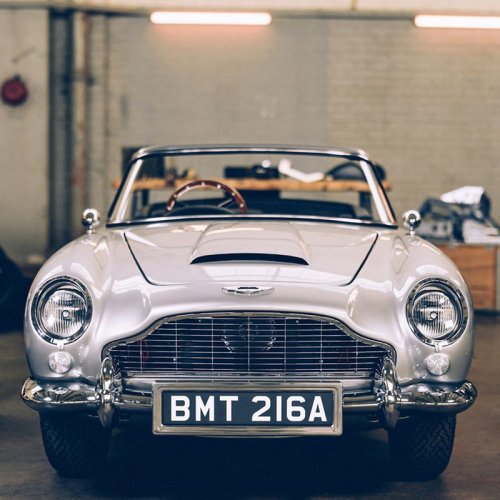
This is the real one. Bond's Aston Martin. Equipped with the best gadgets you can imagine: oil slick, wheel shredder, ejection seat, machine guns. All this comes at a price and if you look closely you can see what this price was:
...
The car has no wipers!

I added some flaps to the wheel boxes to give the bottom something to hold on to.

I painted the inner window frames grey to blend them into the basic colour of the interior. Leaving them light grey would make them show on the final model.

When I was dry-fitting both body halves I was shocked: The driver's cabin sat much too low in the body! I was trying back and forth to make that darn thing fit as intended but to no avail. The instructions do not tell you whether the tub has to be attached to the bottom or to the body frame. As I found out the hard way it has to be attached to the body frame. My mood was not the best, I can tell you.
So I printed another bottom (this time with added flaps), cut the old bottom to pieces to retrieve the cabin and glued the cabin to the body frame.





As a result of this the bottom looked much cleaner now since I had re-arranged the parts to print the part on one page. In addition, because of my sponsored ink I used the high quality printing setting so that there are no longer visible streaks on the bottom.

It was quite a struggle to line everything up. Due to the tropic temperatures here there was a constant danger of leaving sweat stains on the body but I was lucky. I started at the rear and worked myself to the front. Everything proceeded as planned. A few edges were visible but they were painted. I liked the result pretty much.
After that I began work on the detailing.

These are the parts for the side mirrors and the rim detailing.

The mirror mount was straight forward. Just follow the folding marks.

The open area is glued to the chassis later.


I added two more parts for a special effect. All parts were painted silver. So far so good. Then came the wheels.
The wheels are designed in such a strange way. A traditional wheel would feature two even sides which would provide enough material for mounting. The wheels of this kit are nothing like this. I am not a fan of them and I have no idea why the designer created them that way. They consist of way too many parts, construction is very time consuming and on the finished model you do not see most of the work that went into its construction. The inner rim is hollow. The provided holes in the middle of the rim are good for positioning but they are too big for toothpicks and too small for shashlik rods. So I chose to glue the ring of the inner rim directly to the wheel box. That of course looked strange, the wheels sat too close to the body. So I cut them off again which led to some minor damage to the wheel boxes and rims.

Looking at the front of the chassis I noticed that there was no rear mirror included. Of course the main body was glued tightly together and every attempt of opening it again would lead to its imminent destruction. So I decided to glue a small rectangle painted in silver to the outide of the front window.

Since it is reflective you don't really notice that the mirror was glued to the outside.
Another part which eludes me is the front grill. Once you attach it you don't see anything behind it any longer. This is also frustrating considering how much time went into the construction of the recess (which I carefully transplanted from the first build as you remember). However, this design choice can be explained. If you print the grill on transparent sheet and attach it or if you add a real grid you could see through it and see the recess which would add a 3D effect. Nevertheless a small note in the instructions could have told the builder to skip the recess and attach the grill directly.
The front lights were equipped with clear lenses. Again, the kit does not offer a template for them.
To make things clear: The model is beautiful but the kit is riddled with very odd design choices like over-desigend parts the detail of which cannot be appreciated on the final model, unclear foldings, missing placement marks, hollow inner rims on the wheels, no wheel spacers, important notes missing from the instructions and even missing parts like the rear mirror. If it wasn't for the beauty of the car and the fact that I am on the finishing line with it I was at the point to flatten that thing yesterday. No kidding.

Ah well. It could have been worse. Like this:

This is the real one. Bond's Aston Martin. Equipped with the best gadgets you can imagine: oil slick, wheel shredder, ejection seat, machine guns. All this comes at a price and if you look closely you can see what this price was:
...
The car has no wipers!

Last edited:
Once again, your skills as not only a master designer, but as a master builder shine thru. The complex curves on this car would drive me bananas.
Great Work!
Great Work!
Thank you all! 
I tried to come up with an effective solution to the mounting problem which would not require too much additional work. So I cut out four strips and a new disc.
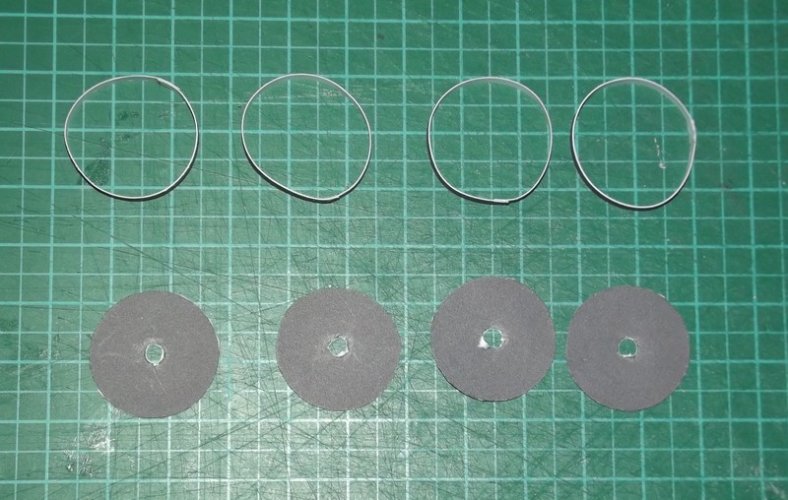
These were edge-glued together and then attached to the inner rim of the wheels.
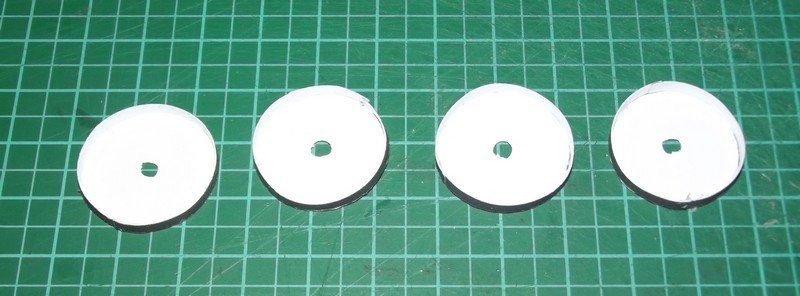
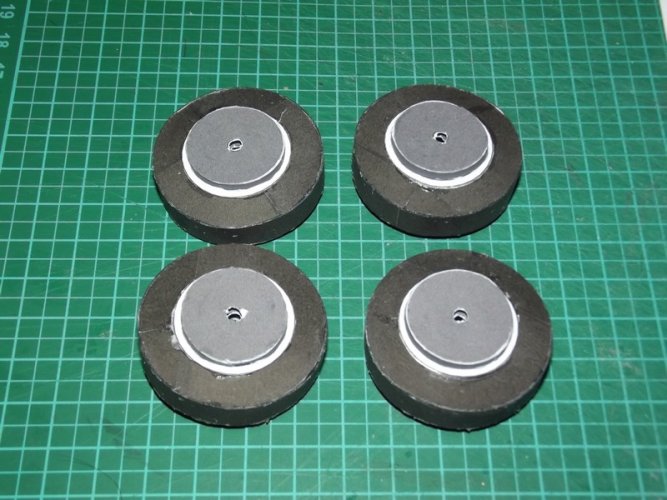
The body received its bumpers and number plates. Much to my surprise the bumpers fit like a glove and this time the sketches in the instructions showed the correct position of the "battering ram thingies".
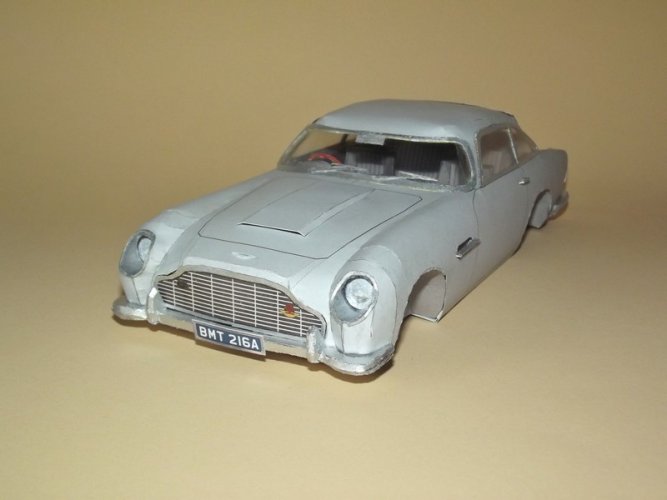
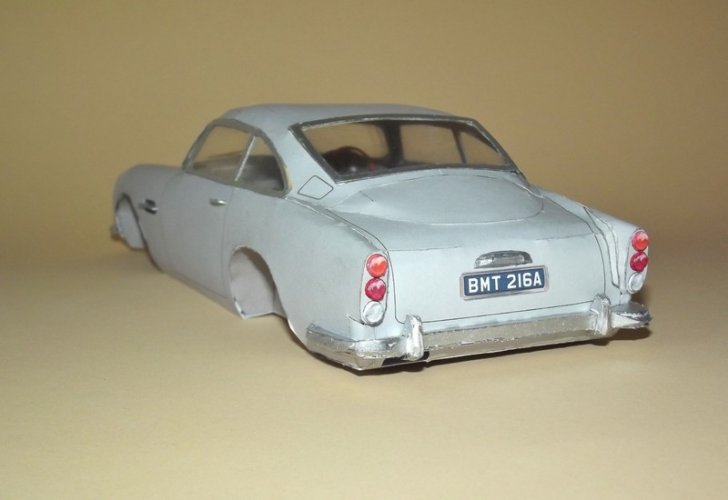
I tried to come up with an effective solution to the mounting problem which would not require too much additional work. So I cut out four strips and a new disc.

These were edge-glued together and then attached to the inner rim of the wheels.


The body received its bumpers and number plates. Much to my surprise the bumpers fit like a glove and this time the sketches in the instructions showed the correct position of the "battering ram thingies".


When I looked at the chassis I noticed that a crucial element was missing: The opening portion of the rooftop which is activated before the ejector seat sends the passenger to the heavens. I created a hatch and printed it. Unfortunately the colour was different because I had to replace two empty ink cartridges. The print could not be used and I had to switch to plan B. Using the print I created a stencil and traced the shape of the hatch with a pencil.
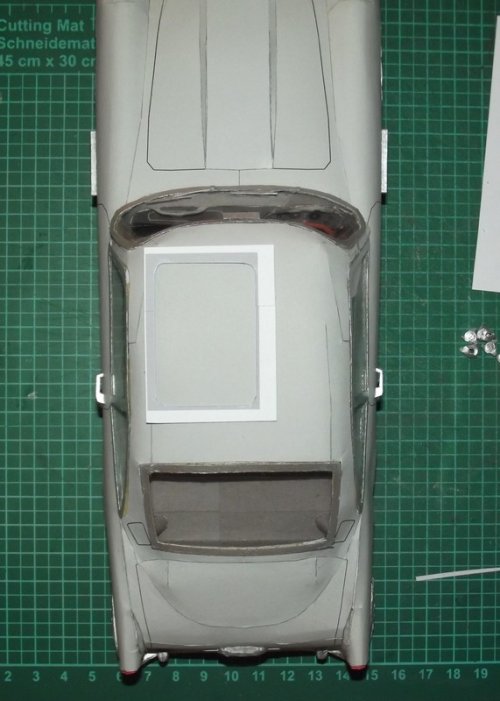
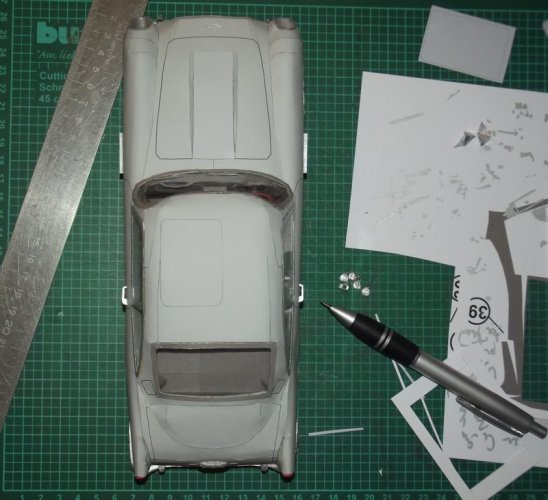
Due to the flash the line appears lighter in some places but please believe me, everything looks good.
Now I returned to the wheels.
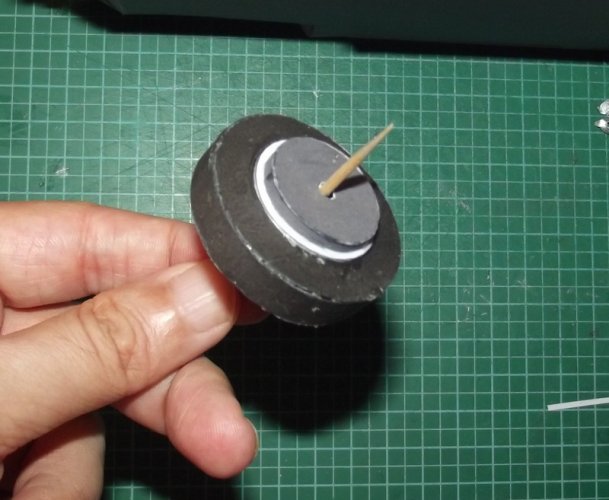
I used some toothpicks to determine the exact position on the chassis which worked extremely well. The front wheels were attached and then left to dry.
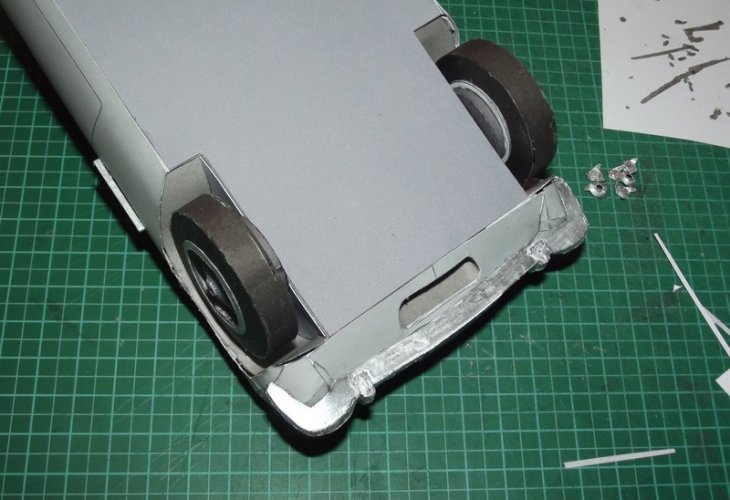
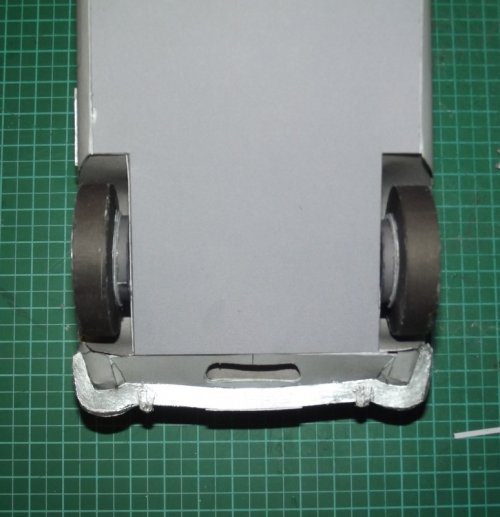
Then came the special effect.
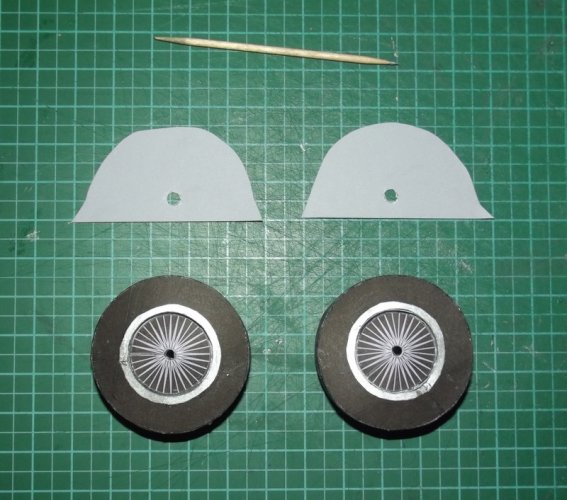
Basically it is the same procedure as with the front wheels EXCEPT for one little difference:
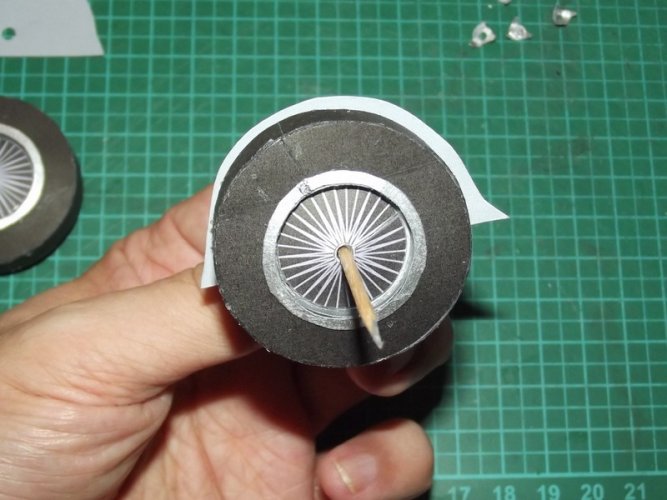
The wheelbox coverup is glued directly to the wheel now.
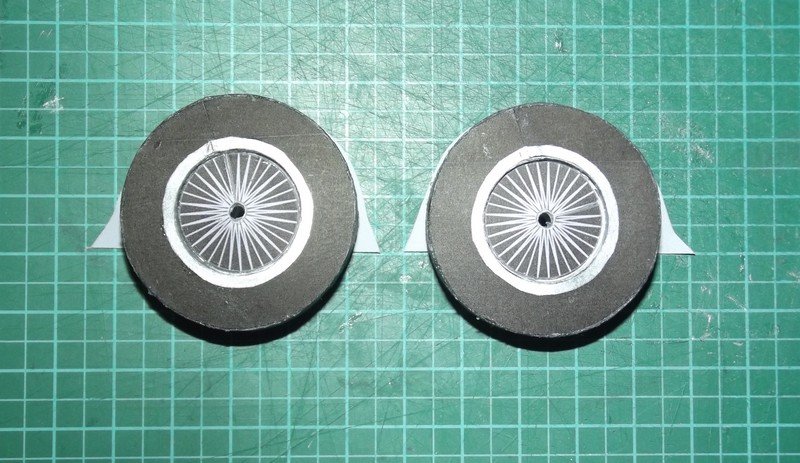
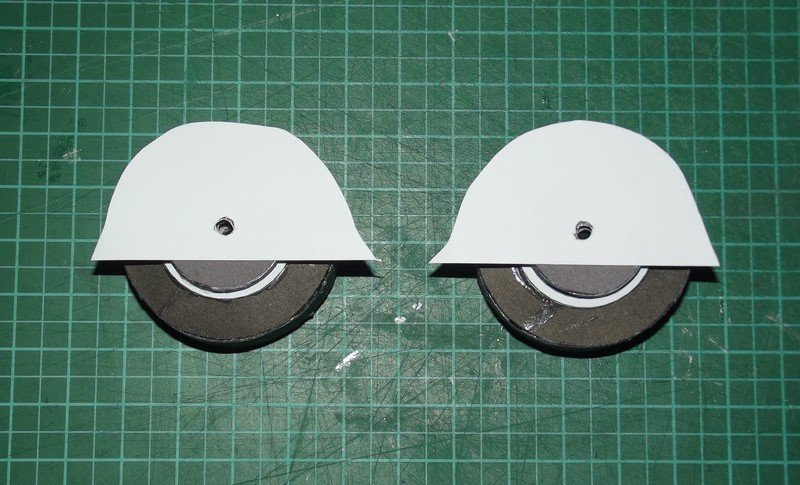
The pointy tips of two toothpicks were cut off. One end was covered with a paper strip, the other was painted silver.
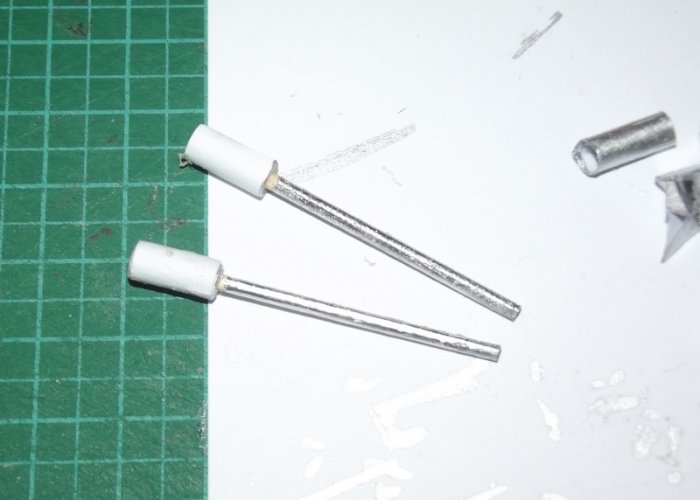
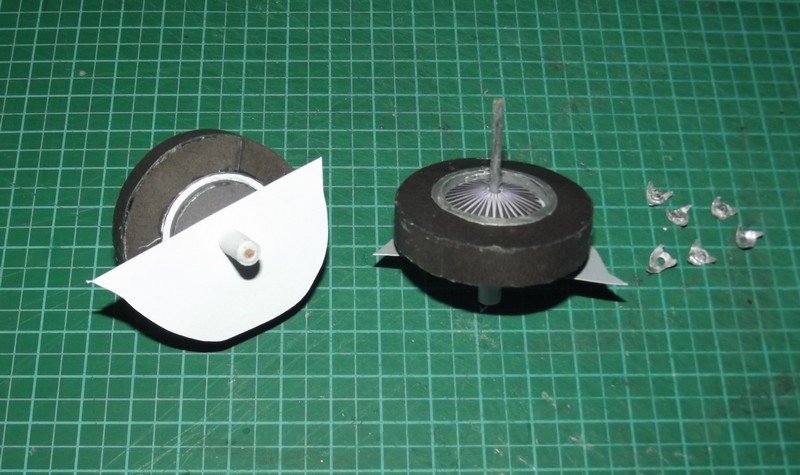
The toothpicks were pushed through the holes in the middle of the wheels.
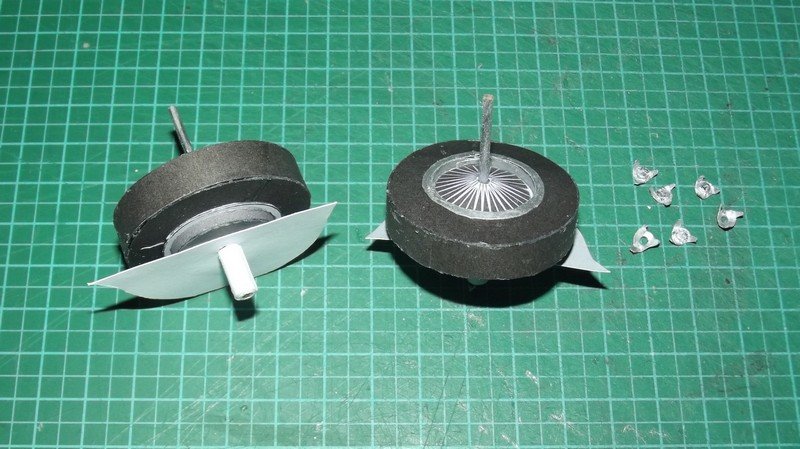
OK, they fit. For a moment I removed them to add a new part:

Another test fit:
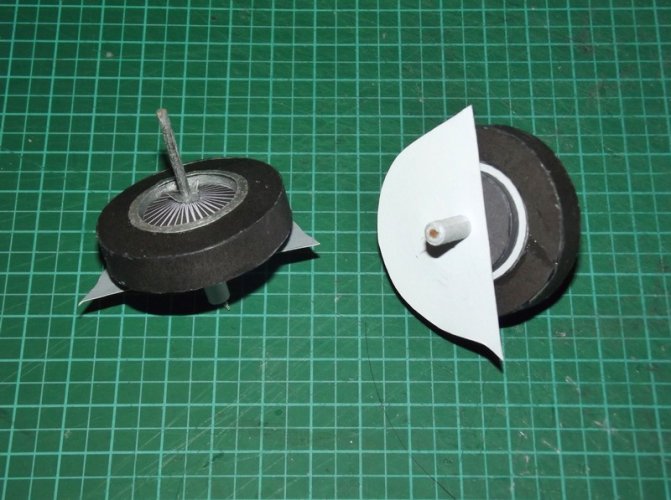
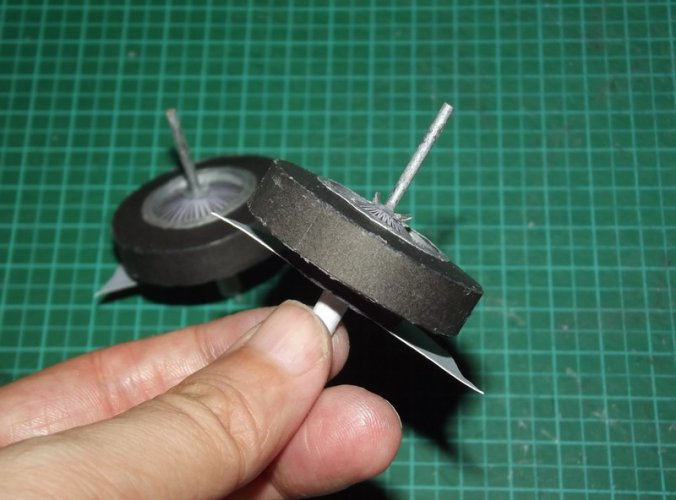
Everything went as planned.
The final component was added to the empty tip:

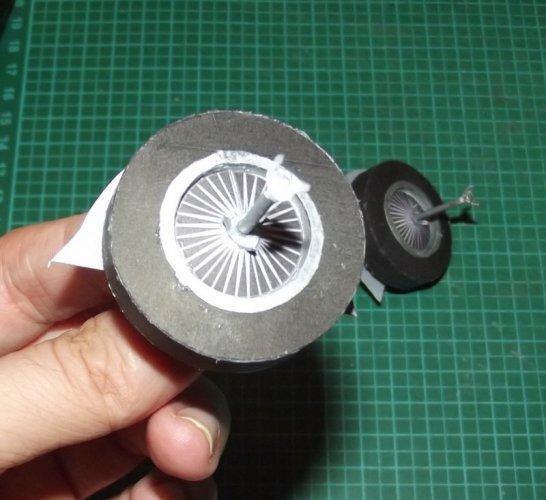
And here we have fully functional wheel shredders! They move in and out and turn around, just like in the movie. Now you may understand why it was necessary to cut a big hole into the wheelboxes: To allow the bigger end of the toothpick to be inserted into the chassis when the wheels are glued tightly to it.
In retrospect the missing wheel spacers made this possible. My initial plan was to add static shredders to the build since it would have been too complicated to add them during the mating of the two body halves. This solution gives the model some authenticity because the shredders are one of the key features of the car I wanted to replicate. To quote my dear friend Bob:
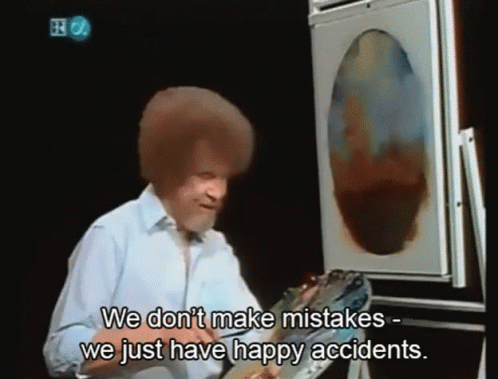



Due to the flash the line appears lighter in some places but please believe me, everything looks good.
Now I returned to the wheels.

I used some toothpicks to determine the exact position on the chassis which worked extremely well. The front wheels were attached and then left to dry.


Then came the special effect.

Basically it is the same procedure as with the front wheels EXCEPT for one little difference:

The wheelbox coverup is glued directly to the wheel now.


The pointy tips of two toothpicks were cut off. One end was covered with a paper strip, the other was painted silver.


The toothpicks were pushed through the holes in the middle of the wheels.

OK, they fit. For a moment I removed them to add a new part:

Another test fit:


Everything went as planned.
The final component was added to the empty tip:


And here we have fully functional wheel shredders! They move in and out and turn around, just like in the movie. Now you may understand why it was necessary to cut a big hole into the wheelboxes: To allow the bigger end of the toothpick to be inserted into the chassis when the wheels are glued tightly to it.
In retrospect the missing wheel spacers made this possible. My initial plan was to add static shredders to the build since it would have been too complicated to add them during the mating of the two body halves. This solution gives the model some authenticity because the shredders are one of the key features of the car I wanted to replicate. To quote my dear friend Bob:

Last edited:


